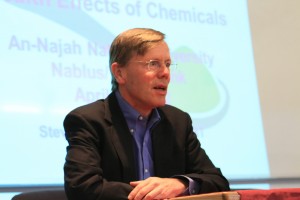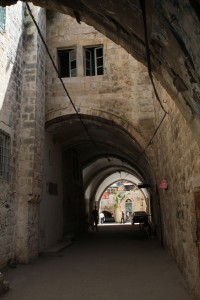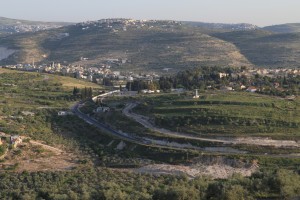A visit to Nablus, by Gerri Haynes
(Gerri Haynes, a former president of Washington Physicians for Social Responsibility, is once again sending back reports from inside blockaded Gaza. As she did four times before, Gerri has organized a team of doctors and other health care providers to work in hospitals and clinics in Gaza in an effort to directly help the people there and to bring attention to the ongoing humanitarian crisis that the Israeli blockade has created. Tenth in the series.)
Early this morning, we drove north through Palestinian villages and past innumerable illegal Israeli settlements – all built on land occupied since 1967. The good rainfall of the spring has turned the hills green – the land is beautiful! How wonderful it would be to have peace here.
In Nablus, students and their instructor, Ansam Sawalha, PhD of the School of Pharmacy at An Naj University, greeted Steve Gilbert. Steve’s historical toxicology papers and poster were displayed on large bulletin boards – a celebration of his work. Steve gave an excellent talk on Toxicology, addressing lead, mercury, pesticides
and paratoxicology. The students listened attentively and asked good questions – and expressed the hope for more work with Steve.We met with the Mayor and Water Minister of Nablus and were treated to a fascinating tour of the old city. We were then were driven to the site of a new water treatment plant for a dedication ceremony. Full water treatment will be available for Nablus by the end of this year. Prior to this time, sewage flowed directly through the earth by gravity, seeping into the earth toward Tulkarem where the remaining sewage drains into the earth. Presently, in some areas around Nablus, septic wells and water wells are in close proximity. The Municipality of Nablus is addressing this problem.
Following the dedication, we joined the celebrants for a walk through the Greek and Roman ruins located near the village of Sebaste. In this area, John the Baptist is said to have been either killed or buried and a tomb area holds a memorial shrine to him.
The ruins are extensive – the Well of Jacob is nearby, and the Palestinians of this area would like to be able to excavate and develop the area for historic preservation and tourism. The Israeli government, believing that this is historic Israel, will not allow the Palestinians to do this excavation. This is in Area C. Areas A, B, and C were designated in the Oslo Accords of 1993. “A” areas comprise 18% of the West Bank and are under Palestinian control and administration. “B” areas comprise 21% of the West Bank and are under Israeli control and Palestinian administration. “C” areas comprise 61% of the West Bank and are under Israeli control and Israeli administration.A German organization is funding the water treatment plant and hosted a concert in one of the amphitheaters of the ruins and a pizza dinner. We were invited to join the full celebration and knew ourselves to be blessed by this day.
Tomorrow, we drive to Jerusalem – grateful to have visited Nablus!!
2 Comments to “A visit to Nablus, by Gerri Haynes”
-
Want to volunteer abroad? Tips for actually helping someone other than yourself. – Seattle Globalist — June 19, 2012 @ 7:31 am
RSS feed for comments on this post. TrackBack URI



By Tom Buchanan, April 27, 2012 @ 4:04 pm
Gerri, Steve and all:
Thanks again for all the connections and the writing about it, Gerri. Steve G., I know you knocked them upside their heads(and hearts) with your toxics lecture. Bravo for your Arabic-translated poster on the details and history of Toxics-the stuff our societies use up and then dump in other places.
Bob H, always great pictures. Gerri, flawless political reporting with heart.
I’m so proud of you guys. Keep on Kicken’.
See you all home soon,
tom buchanan